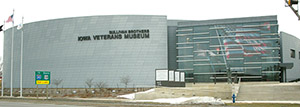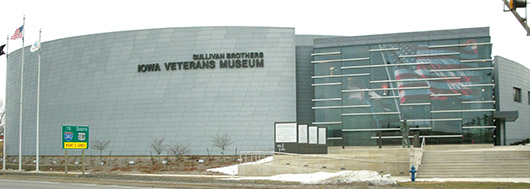
A water faucet line in a janitor closet broke inside the Grout and Sullivan Brothers Iowa Veterans museums last May 23. Water leaked down ductwork into storage areas. An alarm system minimized damage, but a significant number of artifacts were still affected.
Damage totaled about $90,000, District Curator Lorraine Ihnen told the Waterloo-Cedar Falls Courier.
About 100 collection pieces were lost and another 2,000 were affected in some way by the leak, including many clothing items. The museum district has about 186,000 pieces; the total collection is about 300,000 when paper archives are added.
But a silver lining behind that in-house raincloud came in the form of a dedicated corps of University of Northern Iowa students, working with Ihnen and Grout district archivist Catreva Manning.
Students in UNI’s public history program not only helped sort through water-damaged artifacts and documents – as required for the museums to retain professional accreditation – they’ve been categorizing and compiling a record of all items on computer – something the regular Grout staff could not have done by themselves.
“We don’t have a lot of stuff in our database,” Ihnen said – less than 4 percent of the museums’ total combined collection. “It’s a big process to do,” and time consuming with limited regular staff.
“We have to document everything we lost for museum purposes,” she said. “We have to have a track of it. We have to write it up, count it, photograph it. We’re an accredited museum. We have to track that stuff. And we had to have a list for the insurance company.
“The students now are getting all of those reports and the data and the photographs and the data into our database so we have a digital record of it.
“This was an amazing amount of work that had to be done because of the (flood) event,” Ihnen said, in addition to accepting and cataloging new donated items coming into the museums daily and doing programs for the public.
“It has made it possible for us to get work done that needed to be done,” Ihnen said. “In exchange for that, I hope we teach the students about working in museums.”
UNI professor Leisl Carr Childers is coordinator of the university’s public history academic program coordinator, new to that job this academic year. Her job includes finding work experience opportunities. The Grout, she said, is a long-standing and natural one.
Public history, she and Ihnen said, involves hands-on teaching and research in a non-academic venue such as a museum – and actually handling, storing, maintaining and preserving items for the general public to see and enjoy.
Childers said she’s grateful for her students can get have that experience at the Grout district.
“It takes a special set of employees – collections people in this case – to really work with students,” she said. “Not everybody is open to having interns. You really have to be good and focused on the students, good at articulating the work you want them to do, patience in answering questions. So this is a rare relationship.”
It’s one UNI and the Grout hope to deepen in the future, Grout executive director Billie Bailey said.
“It’s important real-life experience in determining whether a career in the museum field is for them,” Bailey said.
“It’s great to have their enthusiasm to help us wrap up this chapter,” Bailey said of the flood disaster. “Leisl and I are really excited about the possibility of this being a standing practicum every year. We’ll have them working in educational programming, marketing and publicity and they’ll also help do research for exhibits. It’s nice to have a fresh perspective.”
“I’ve been on the other side of that. I’ve been a student,” Ihnen said, herself a product of the UNI program. “I’m paying it forward and I hope half of these students end up in museums. Then they can teach the next generation.”
___
Information from: Waterloo-Cedar Falls Courier, http://www.wcfcourier.com
Copyright 2014 Associated Press. All rights reserved. This material may not be published, broadcast, rewritten, or redistributed.
AP-WF-02-23-14 1700GMT
ADDITIONAL IMAGE OF NOTE



